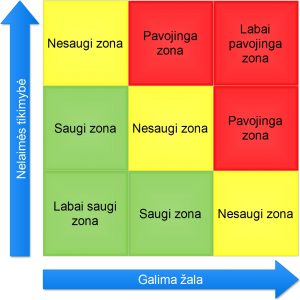Recently, the Ministry of Health announced the publication of our book – “Color coding. A book of recommendations.” This book is aimed at a wide range of healthcare and other institutions, businesses and anyone else who wants to manage the flow of people and the risks of COVID-19 where such flows can be separated.
It is not a big book, it is written in such a way that you can read it without bother, and even after reading a quarter of the book, you can start to implement all the labels in your organization. The book can be used as a practical risk management tool.
There is also a summary in the book, where the essentials are condensed into just a few pages. But this entry will make things even simpler – with basic points, questions and answers on what, how and why.

The fundamental idea of color coding is based on the classic risk matrix, well known to experienced managers: high risk is where there is a high probability of a high damage event. To manage risks, both the probabilities of events and the amount of damage they can cause must be considered.
Red and green zones
Let’s start by colour-coding the primary traffic (premises and customers):
-
- Red means that there are infected persons in the area and therefore everyone is at risk. However, the patients there cannot infect each other because they are already infected. It is a dangerous area.
- Green means that there are no infected persons in the area, so everyone is safe. However, the area needs to be heavily guarded to prevent contamination from the outside. It is a safe zone.
Why have a yellow zone?
Imagine that there is a red zone, there is a green zone, and there is a new patient in the hospital who is still untested. Where should he be? He must not be in the red zone because maybe he is not infected with anything. But he must not be in the green zone either, because maybe he is infected.
What’s more, the patient may need very urgent care – sooner than the test results are available. This means that such a patient needs to be treated, but cannot be moved to either the green or red zone.
So there must also be a separate area for such unknown patients.
The yellow zone is the hardest to manage and requires the most effort, because here we do not know which patients are infected and which are not – so we have to protect everyone from everyone.
The hardest job, and the one on which the whole hospital depends the most, is the organization of the yellow zone.
What is a sluice zone and why do you need one?
Imagine that you are in a red zone, which is considered to be infected – this means that in order to manage the process well, all things, just everything that is there, is considered to be infected. Those things cannot get into the green zone in any way unless they are disinfected. Once an item has gone from the green zone to the red zone, it cannot go back to the green zone.
Now imagine that you have to move from the red zone to the green zone. This means that you have to take off your contaminated clothes, disinfect yourself and then you will be clean and fit for the green zone.
Where will you do this?
If you change clothes in the red zone, this means that contaminated things from the red zone are allowed to move into the green zone, because you will be wearing your new clothes while still in the red zone. If you change clothes in the green zone, it will also mean the same thing, because you will move into the green zone while wearing dirty clothes.
That’s what changing areas are for – where you can simply take off your old clothes, wash and disinfect yourself, and put on your new clothes.
These areas must not be used for any work – so they have to be separated into separate zones and marked with a different color – e.g. blue.
How to prevent the spread of infection from zone to zone?
This is the main purpose of color coding and it is very simple to do:
- All staff who enter the red zone shall mark their clothes with a red marker. If a person with a red marker is seen in the yellow or green zone, it means they have broken the rules, and everyone can see that.
- Similarly, clothes are marked for the yellow zone – and then everyone in the green zone also sees that someone has come from the yellow zone without changing.
- Equipment is marked in a similar way, which means that it is immediately obvious when the equipment marked in red has strayed into the green zone.
- The cards that are marked with the corresponding color are transported with the patients or clients, which means that an uninfected patient will not be able to enter the red zone, while an infected patient will be not be able to enter the green zone.
After all, when everyone can clearly see where and what zone they are in (because there must be visible, easy-to-see markings everywhere, in all rooms visible form all angles), it is very easy for everyone to intuitively comply with the safety requirements for one or another zone.
Pratura teikia procesų gerinimo paslaugas įvairiose srityse - projektų valdymo, tiekimo, pardavimų, gamybos, klientų aptarnavimo ir kt..
Susisiekite su mumis ir mes jums padėsime pagerinti procesus jūsų įmonėje:


Leave a Reply